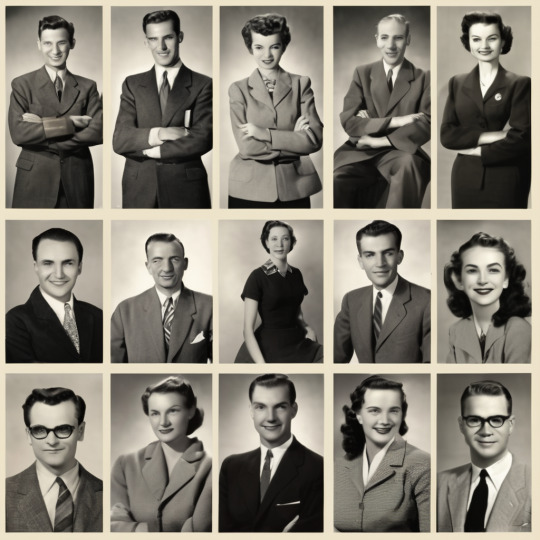#EmploymentIssues
Explore tagged Tumblr posts
Text
The Rise of Human Resource Management in the 1950s: Organizational Change, Behavioral Science, and the Human Relations Movement

The 1950s marked a pivotal moment in the development of Human Resource Management (HRM) as companies began to recognize the strategic importance of managing human capital in the face of rapid industrial expansion. This period saw the rise of mega-corporations like General Motors, IBM, and Sears Roebuck, whose sheer size necessitated more systematized and centralized personnel practices. Simultaneously, the growing fields of industrial psychology and sociology, combined with the human relations movement, transformed how organizations approached employment issues. This essay delves into the evolution of HRM during the 1950s, examining the influences of organizational change, the application of behavioral science, and the human relations movement. It will highlight how these factors shaped HRM’s trajectory and provided new opportunities for growth and innovation within organizations.
Organizational Change and the Rise of the 'Organization Man'
The 1950s witnessed a shift in the structure of American corporations as industries grew rapidly after World War II. This era of economic prosperity brought about the rise of large, bureaucratic corporations, leading to the term "organization man," popularized by William H. Whyte in his 1956 book The Organization Man. Middle management and white-collar employees became the backbone of these expanding organizations, and companies like General Motors and IBM developed extensive management hierarchies to coordinate and control their operations.
The growth in corporate size required more systematized and formal personnel management practices. Organizations could no longer rely on informal, ad hoc methods of managing employees. Instead, they needed structured systems for recruitment, selection, performance appraisal, training, and compensation. This shift in management practices was largely driven by the increasing complexity of operations within these mega-corporations and the need for consistency and fairness in managing large, diverse workforces.
For example, General Motors in the 1950s developed a robust system of employee training programs and career development initiatives designed to ensure that employees at every level were equipped with the necessary skills to meet the company’s needs. By formalizing HRM practices, GM could create a more predictable and stable workforce, minimizing turnover and aligning employee performance with corporate goals.
The Application of Behavioral Science
Alongside the organizational changes in the 1950s, the application of behavioral science to HRM became a prominent trend. In the previous decades, industrial psychology had focused on narrow technical applications, such as employee selection tests and fatigue studies, but the 1940s and 1950s saw a shift towards more complex psycho-social issues. Topics like employee morale, work group dynamics, and non-financial incentives gained increasing attention among behavioral scientists.
The human relations movement, which had its roots in the famous Hawthorne experiments conducted at the Western Electric Company in the late 1920s and early 1930s, was one of the primary influences on this shift. Led by Elton Mayo, the Hawthorne studies initially set out to examine the effects of physical working conditions on productivity but quickly uncovered the importance of social factors. Mayo and his colleagues found that employees' performance was significantly influenced by factors such as attention from supervisors, group cohesion, and perceived value within the organization. These findings challenged the prevailing view that financial incentives alone could motivate workers and instead suggested that non-financial incentives, such as recognition and social belonging, played a critical role in shaping employee behavior.
In the 1950s, companies began to apply the lessons of the human relations movement to their HRM practices. For example, IBM was an early adopter of many human relations principles. The company invested heavily in employee welfare programs, training, and leadership development, recognizing that fostering positive social relationships within the workplace could enhance productivity and reduce turnover. IBM’s focus on employee satisfaction and morale became a model for other companies seeking to improve worker retention and organizational culture.
The Human Relations Movement and Its Influence on HRM
The human relations movement continued to gain momentum throughout the 1950s, with HRM becoming a key beneficiary of its findings. The movement emphasized the importance of understanding employees as individuals with psychological and social needs, rather than simply as economic actors responding to financial incentives. This new approach to HRM had several important implications for how companies managed their workforces.
First, the human relations movement highlighted the role of leadership in fostering employee motivation and morale. The traditional authoritarian, top-down management style was increasingly seen as ineffective for motivating employees in the modern workplace. Instead, HRM practices began to focus on participatory management techniques, where supervisors were encouraged to engage employees in decision-making processes and provide opportunities for feedback and collaboration. This shift in management style helped create more engaged, motivated, and productive workforces.
One prominent example of the human relations movement in action was the leadership practices at Sears Roebuck. The company implemented several programs designed to improve communication between employees and management, including regular employee satisfaction surveys and open forums where workers could voice concerns. These initiatives helped foster a more positive organizational culture, where employees felt valued and heard, resulting in increased job satisfaction and loyalty to the company.
Second, the movement encouraged companies to pay greater attention to the social dynamics within workgroups. Research from the Hawthorne studies and subsequent behavioral science experiments revealed that small workgroups could have a profound impact on employee morale and productivity. As a result, HRM practices began to incorporate team-building exercises, social events, and other initiatives designed to strengthen group cohesion. This emphasis on social dynamics in the workplace became a hallmark of HRM during the 1950s and beyond.
For instance, Procter & Gamble, a leader in consumer goods, introduced team-based structures within its factories to improve communication and cooperation among workers. These teams were empowered to make decisions regarding their work processes, fostering a sense of ownership and accountability among employees. The company's emphasis on teamwork and employee involvement not only improved morale but also led to significant gains in productivity and operational efficiency.
Challenges and Opportunities in the 1950s
While the 1950s were a time of significant progress for HRM, the field also faced several challenges. One of the most persistent issues was the tension between the growing importance of HRM within organizations and its relatively low status compared to other corporate functions. Although companies recognized the value of effective personnel management, HRM was often seen as an administrative function, focused on compliance and employee welfare, rather than a strategic driver of business success.
Moreover, the rise of unions and collective bargaining during this period posed a challenge for HRM. Many companies found themselves in adversarial relationships with labor unions, which often took the lead in negotiating wages, benefits, and working conditions. This limited HRM’s ability to shape employment policies and procedures and contributed to the perception that HRM was primarily a reactive function, rather than a proactive force for organizational change.
Despite these challenges, the 1950s also offered new opportunities for HRM to expand its influence. The growing interest in behavioral science and the human relations movement provided HRM with a framework for understanding and addressing complex employee needs. Companies that embraced these principles saw significant improvements in employee satisfaction, retention, and productivity, demonstrating the value of a more human-centered approach to management.
Conclusion
The 1950s were a transformative period for Human Resource Management, driven by the rise of large corporations, the application of behavioral science, and the human relations movement. As companies like General Motors, IBM, and Sears Roebuck expanded, they developed more formal and centralized HRM practices to manage their growing workforces. The insights gained from industrial psychology and the human relations movement helped HRM professionals recognize the importance of non-financial incentives, leadership, and social dynamics in shaping employee behavior.
While HRM faced challenges, such as its relatively low status and the rise of unions, the 1950s provided a foundation for the field’s future growth. By embracing the principles of the human relations movement and focusing on the psychological and social needs of employees, HRM professionals were able to create more engaged, motivated, and productive workforces, setting the stage for the continued evolution of HRM in the decades to come.
#HRM (Human Resource Management)#1950s#IndustrialExpansion#StrategicImportance#HumanCapital#MegaCorporations#GeneralMotors#IBM#SearsRoebuck#SystematizedPersonnelPractices#CentralizedHRM#IndustrialPsychology#Sociology#HumanRelationsMovement#OrganizationalChange#BehavioralScience#EmploymentIssues
1 note
·
View note
Text
Is the Argentine economy okay as it is?

Argentina's economy
Argentina is grappling with a severe economic crisis characterized by soaring inflation rates, currency depreciation, and dwindling employment opportunities. As of October 2018, the country's consumer price inflation rate stood at 45.9%, the highest since 1991.
Some of the factors contributing to Argentina's inflation problem include
Devaluation of the Argentine peso: This is mainly due to the government's fiscal policy and foreign currency borrowing issues. Lack of employment: A lack of jobs can increase demand, which can drive up prices. Inflation itself: Inflationary expectations contribute to higher inflation rates. Decline in agricultural output: Climate change has led to a decline in productivity, which in turn has led to a decline in agricultural output.
What can I do?
To mitigate the ongoing economic crisis, the Argentine government and central bank have implemented a number of measures, including raising interest rates and announcing price stabilization measures. However, these efforts may not be enough and additional actions are needed.
Focus on reducing the inflation rate: Policy reforms in agriculture, transportation, energy, and other industries can help increase productivity and stabilize prices for products and services. Take steps to stabilize prices: Governments should monitor the rate of inflation and adjust prices when necessary to protect consumers. Transparent information: Providing citizens with accurate information about economic conditions can help them understand the situation and take action.
#ArgentinaEconomy#InflationCrisis#ArgentinePeso#EconomicReform#PriceStabilization#EmploymentIssues#AgricultureCrisis#ClimateChangeImpact#PolicyReforms#FinancialRecovery
0 notes
Link
I often don't like when something as ingenious an idea as Slinkachu's miniatures gets used for advertising purposes but I think it works here. Raising awareness about the employment issues we are facing in Europe has been tackled in a really interesting way.
1 note
·
View note